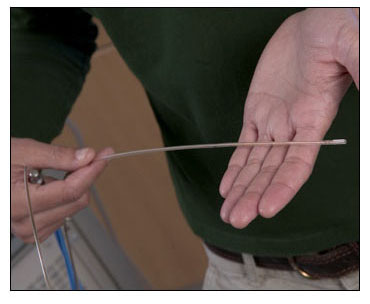MADISON, Wisc., July 15 -- A new technology developed by a research group at the University of Wisconsin-Madison uses a fiber optic probe to increase the accuracy of breast cancer diagnoses by being a "third eye" during biopsies.
Nimmi Ramanujam, assistant professor of biomedical engineering, and her group have built fiber optic probes that doctors can easily thread down a biopsy needle to the tip to help them find the right area to sample. The researchers are testing probes in both the near-infrared wavelength, which allows light to go deeper but probes fewer molecules, and ultravioloet (UV)-visible wavelength range, which allows them to probe more molecules but with limited sampling depth.

Biomedical Engineering Assistant Professor Nimmi Ramanujam (holding biopsy needle, center) and graduate students Carmalyn Lubawy (left) and Changfang Zhu have developed an optical probe to help doctors biopsy breast tissue more accurately. The probe slides into the hollow biopsy needle doctors currently use.
(Photos on this page: David Nevala)
Doctors currently use x-ray or ultrasound -- 2-D pictures -- to guide a biopsy needle into a 3-D region. To ensure they are doing the biopsy at the right spot, they take up to a dozen tissue samples.
"If you're in the wrong spot and you don't get the cancer, then you're basically concluding that this woman doesn't have a disease that needs to be treated," says Ramanujam. She says missed diagnoses occur in about 7 percent, or 70,000, of women who have biopsies. An additional 6 percent of women who have biopsies must have the procedures repeated because the results are inconclusive.
Ramanujam and graduate students Carmalyn Lubawy and Changfang Zhu are harnessing the power of light to add another dimension of information about the tissue properties at the needle tip. Light can provide structural information such as cell or nuclear size, as well as measurements of hemoglobin oxygenation, vascularity and cellular metabolic rate -- all of which are hallmarks of carcinogenesis and can indicate whether the needle has hit the mark, she says.

Current biopsy needles are about the diameter of a pencil, but the group's probe is so thin that doctors could use it with an even smaller needle.
"These chemical and structural features are intrinsic inside tissue," she says. "They're not things you have to add, so you don't have to add any dyes to make it work."
Initially, they used the probe to analyze healthy and cancerous tissue samples from patients who underwent surgery and identified cancerous tissue with 90-percent accuracy. Now, with two grants totaling more than $1.2 million from the National Cancer Institute and National Institute of Biomedical Imaging and Bioengineering, the group will test the probe during biopsies of about 250 patients. At project's end, the researchers will determine which light wavelength is best, or whether the optimum technology combines the two.
While the fiber optic probe won't eliminate the need for a biopsy, it will increase the likelihood that doctors will take a sample from the correct site. And because of improved optical technology, doctors may be able to make diagnoses right away, says Ramanujam.
Also, the probe can be made thin enough to fit through an even smaller needle than the standard 1/4-inch size, making a stressful procedure less physically traumatic.
The group is patenting the technology via the Wisconsin Alumni Research Foundation.
For more information, visit: www.engr.wisc.edu/bme